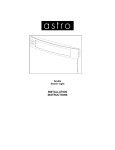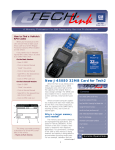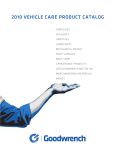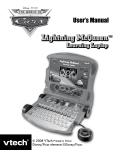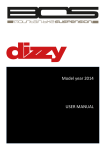Download 537835 rev.B TPM Manual - Bill.p65
Transcript
8/23/07 537835 rev.B ©2007, SPX Corporation • Printed in U.S.A • All Rights Reserve 1 SPX KENT-MOORE Model: J-46079 FCC ID: RP3-J46079 IC: 4811A-J46079 This device complies with part 15 of the FCC Rules and with RSS-210 of Industry Canada. Operation is subject to the following two conditions: (1) this device may not cause harmful interference, and (2) this device must accept any interference received, including interference that may cause undesired operation. The term “IC” before the radio certification number only signifies that Industry Canada specifications were met. 2 3 General Motors is adding radio frequency (RF) TPM systems on many of their vehicles. The TPM system consists of a RF transmitting pressure sensor inside each wheel/tire assembly and a receiver in the vehicle. The receiver receives and translates the data contained in each sensors transmission into sensor presence, sensor mode, and tire pressure. The receiver then sends the tire pressure and tire location data to the instrument panel cluster via the serial data circuit, where the individual tire pressures and their locations are displayed (on some vehicles) or, the system will notify the driver if a significant loss of tire pressure has occurred. The J-46079 TPM diagnostic tool will test the TPM system and can also be used to activate the sensors (on some vehicles) after a tire rotation, so the receiver can learn the new sensor locations. The rechargeable battery pack included in the J-46079-30 kit is recommended for the J-46079 tool. Three standard rechargeable or alkaline C cell batteries may also be used. The tool displays its battery level in the upper left hand corner of the main display. When using rechargeable batteries J-46079 will ask the question whether alkaline or rechargeable batteries are installed in the tool. This question has to be answered correctly to display the proper battery level. Sensor transmission signal strength is displayed in the upper left corner of the main display next to the tool's battery level display. When the tool is used in both activate, or scan mode, it will receive the sensor's transmission and indicate its signal strength. It is important to note the sensor's transmission signal strength after a sensor is activated by using the TPM diagnostic tool in activate mode, or activated by using the J-41760 sensor activating magnet. Tire Rotation It is important that the receiver has learned the correct locations of each tire pressure sensor so the system indicates the correct location of the tire pressure condition, as well as sensor location for diagnostic procedures. The sensor learn procedure must be performed after every tire rotation, sensor replacement, or receiver replacement. NOTE: SOME VEHICLE MODEL YEARS REQUIRE THE J-41760 MAGNET TO ACTIVATE THE SENSORS. THE J-46079 CANNOT ACTIVATE THE SENSORS ON SOME VEHICLES (CORVETTE, SEVILLE, DEVILLE). REFER TO VEHICLE SERVICE MANUAL FOR MORE INFORMATION. 1. Enable the tire pressure sensor learn mode in the receiver. Refer to vehicle service manual for more information. 2. Starting with the left front tire, hold the antenna of the J-46079 TPM tool against the tire sidewall close to the wheel rim at the valve stem location. 3. Press and release the Activate button. The main display will show moving waves during activation and then the sensor will transmit. The tool will display the sensors transmission data and signal strength, a horn chirp will sound within 35 seconds. 4 4. After a horn chirp has sounded, proceed as in step 3 for the remaining 3 sensor in the following order: o Right front o Right rear o Left rear After all 4 sensors have been learned, exit the learn mode. Refer to vehicle service manual. Testing Tire Sensors The sensor test procedure is used to verify the sensors can transmit valid data after they have been activated with a Low Frequency (LF) transmission from the J-46079 TPM tool, or activated with the J-41760 magnet. This test cannot verify if the sensors internal roll switch is functioning properly, for that, a test drive is necessary. Refer to vehicle service manual for further diagnostic information. During this procedure the J-46079 TPM tool will receive sensor transmissions and display the transmission data on the screen. NOTE: DEPENDING ON THE VEHICLE MODEL YEAR, THERE ARE TWO WAYS TO ACTIVATE THE SENSOR. Model year 2003 and some 2004 (Corvette, Seville, Deville) use magnetic activation: 1. Press and release the Scan button on the tool. The circling symbol indicates the tool is scanning for the sensor's transmission. 2. Hold the J-41760 magnet over a valve stem to activate the sensor. \3. With the J-46079 TPM tool, observe the screen and wait 3-5 seconds for the sensor's transmission to be received. The screen should display an 8-digit ID number, tire pressure within 2 psi of actual tire pressure, learn mode and good signal strength. 4. Proceed as in step 3 for the remaining sensors to verify all sensors are operating properly. Model year 2004 or greater (Low Frequency (LF) activation): 1. Hold the antenna of the J-46079 TPM tool against the tire sidewall close to the wheel rim at the valve stem location. 2. Press and release the Activate button on the tool. The circling symbol indicates the tool is scanning for the sensor's transmission. \3. With the J-46079, observe the screen and wait 3-5 seconds for the sensor's transmission to be received. The screen should display an 8-digit ID number, tire pressure within 2 psi of actual tire pressure, learn mode and good signal strength. 4. Proceed as in step 3 for the remaining sensors to verify all sensors are operating properly. NOTE: SENSOR TRANSMISSION DATA DISPLAYED ON THE TOOL SCREEN IS ERASED EACH TIME THE ACTIVATE, OR SCAN BUTTONS ARE PRESSED. 5 Testing Receivers The receiver test procedure is used to verify the receiver can receive and translate the data from simulated sensor transmissions. 1. Enable the learn mode in the receiver. Refer to vehicle service manual for more information. 2. Locate the J-46079 in a central location in the passenger compartment of the vehicle. 3. Press and release the Simulate button. 4. Press and release the Start button. 5. Press and hold the Simulate button and the J-46079 will begin to transmit a simulated sensor transmission. When the receiver receives the simulated sensor transmission a horn chirp will sound, or the DIC will display the next sensor to be learned. 6. Release the Simulate button. Press and release Yes button after a horn chirp has sounded, or DIC message is displayed. 7. Proceed as in step 5 for the remaining 3 sensor locations until all 4 simulated sensor transmissions have been learned into the receiver’s memory. The J-46079 will display the preset Id numbers and tire pressures for each location. 8. With the scan tool, observe the TPM data list and verify the sensor Ids and tire pressures match what is displayed on the J-46079 screen and all 4 sensor modes are “Learn”. NOTE: ON MODEL YEAR 2001-2004 SEVILLE AND CORVETTE, AND 20012005 DEVILLE, THE SCAN TOOL DOES NOT DISPLAY THE SENSOR ID'S, OR MODE AND CAN ONLY BE USED TO VERIFY TIRE PRESSURE/LOCATION DATA. 6 TPM System Diagnostic Aids The J-46079 does not receive a sensor transmission after a sensor has been activated. After activating a sensor with either the J-46079, or J-41760, the sensor mode in the transmission received was not "Learn". Hold the tool's antenna within 6 inches of the sensor when activating a sensor. This process may need to be repeated up to 3 times. If a sensor continues to not respond, refer to the vehicle service manual for further diagnostic, or repair information. The tool has received a random transmission from another sensor on the vehicle, or from a sensor on another vehicle. The mode displayed should always be "learn" when the sensor is activated with the either J46079, or J-41760. A sensor DTC is set and current in the vehicle's receiver but after performing the tire pressure sensor test the J-46079 is indicating a malfunctioning sensor in a different physical location than the DTC's descriptor. The sensor Ids and their last learned locations noted in the scan tool's TPM data list (on some vehicles) can be compared to the Ids and physical locations noted with the J-46079 display to determine if the sensors have become mis-located due to a previous tire rotation where the sensor learn procedure was not performed. When performing the receiver test, the vehicle's receiver does not learn the simulated sensor transmissions from the J-46079. Locate the tool closer to the receiver and repeat the simulation test, also verify the vehicle's horn is functioning. After the receiver test, the preset tire pressures displayed on the J46079 screen do not exactly match the tire pressures displayed on either the vehicle's DIC, or the scan tool's TPM data list. Since some vehicle receivers compensate for barometric pressure, the tire pressures displayed on the scan tool and the DIC can differ as much as 4 psi from the preset tire pressures displayed on the J-46079 screen. The receiver test is intended to verify the receiver's ability to receive a simulated sensor transmission and not necessarily its ability to accurately translate pressure data. 7 Battery Charger This guide presents the setup, use, maintenance and troubleshooting of the charger along with a method to optimize your batteries. Desktop Place the charger on a solid, level surface that is free of debris (for additional information on Safety Guidelines see page 6). Ensure the power cord is unobstructed to prevent damage, stress or injury. Parts of the Tire Pressure Monitor Charger Legend 1. Battery Charger 2. Battery Status Display 3. Contacts 4. Power Supply 5. Power Cord Safety Guidelines Before using the battery charger, read all instructions and cautionary markings on the battery charger, battery, and on any product that uses the battery. WARNING To reduce risk of injury, use this charger only with authorized products. Other batteries or adapters may cause personal injury and/or damage. • When securing the power cord, do not pierce rubber insulation. This may cause damage or personal injury. • Do not expose the charger to rain, snow or direct sunlight. • Use the charger at room temperature 20°C (68°F) to 25°C (77°F). • Place the charger in a well-ventilated area free of foreign objects/matter. • To reduce risk of electric shock, unplug the charger from the outlet before cleaning or changing adapters. • Dispose of used batteries in accordance with local hazardous material laws. • Do not disassemble, incinerate, modify or short circuit batteries, charger or related components. Only UL listed power supply marked Class 2 or listed to UL 1950 with SELV outputs should be used with this product. Refer to voltage rating on the product label for correct selection. New Batteries When charging battery packs that are new or have been on a shelf for an extended period of time, the charger may prematurely switch to ready. Perform a battery conditioning cycle on all new NiCd/NiMH batteries before use to ensure the battery is completely and properly charged. 8 Power Supply Connection WARNING • Never alter an AC cord or its plug. If it does not fit into your outlet, have a proper outlet installed by a qualified electrician. An improper connection can cause an electric shock. • To reduce the risk of electric shock, the charger must be grounded. The power supply uses a nominal 115 or 230 volt circuit with a grounding plug that fits one of the outlets shown below. Insert the grounding plug into an outlet that is properly installed and grounded, in compliance with all local codes and ordinances. A temporary adapter can be used to connect the grounding plug to a properly grounded two-prong outlet. A 115-volt adapter is shown in Figure 3. Connect the grounding plug on the adapter to the outlet box using the cover plate screw. Use the temporary adapter only until a properly grounded, three-prong outlet can be installed by a qualified electrician. WARNING • Before using an adapter, ensure that the outlet box is grounded. If you are not sure the box is grounded, have it checked and repaired, if necessary, by a qualified electrician. The power supply manages and conditions the power input to the charger. This device negates the need for a resettable or replaceable fuse. If a power surge occurs the power supply temporarily interrupts the current supply until the condition is corrected. If the power light on the power supply fails to light an extreme surge may have occurred, and the power supply may trigger an internal fuse that must be serviced by the manufacturer. Return the power supply for repair or replacement immediately. 9 NiCD/NiMH* Power: Solid green when power is available. Ready, Standby or Fault: Solid green when battery is ready. Flashing yellow if battery is on standby. Solid yellow if a battery is rejected. Charging: Solid yellow when battery is charging. Charging the Battery Insert the battery into the charger. When the battery is inserted, the charging system begins the rapid charge cycle. When this cycle is completed, the "READY" indicator on the Battery Status Display turns solid green, and the battery is charged to approximately 95% of its rated capacity. To attain 100% of its capacity the battery should remain in the charger for 3 hours. A charged battery may be stored in the charger indefinitely. Upon completion of the charging cycle, the charger switches to "Maintenance Mode" where it maintains the battery at 100% of its rated capacity. CAUTION: Do not charge a battery that is below 0°C (32°F). Allow the battery to warm up to room temperature before charging. Note: The operating temperature of the device is 0°C (32°F) - 50°C (131°F). Charge batteries at room temperature 20°C - 25°C (68°F - 77°F). Batteries that are charged in conditions that are above or below room temperature will exhibit battery cycle life and capacity below their rated values. This also applies to the temperature of the battery itself. Allow batteries that are below 20°C (68°F) or above 25°C (77°F) to adjust to room temperature before charging. 10 Battery Rejection If the Fault indicator on the Battery Status Display flashes (see Figure 4) and is not in condition, the battery is faulty or damaged. If the battery is still within its warranty period, contact the original manufacturer of the battery pack. See Troubleshooting table for actions to be taken. If the rejected indicator continues to flash the battery should be removed and disposed of properly. Conditioning the Battery To condition a battery exhibiting a decrease in capacity, insert the battery into the charger and hold down the "CONDITION" cycle button for two seconds (see Figure 4). The charger performs a complete (100%) discharge of the battery and recharges it to full available capacity, eliminating conditions that may cause it to perform below its rated capacity. This deep discharge cycle may take up to 20 hours to complete. Note: This cycle should only be used on NiCD/NiMH batteries and only once every several weeks. Performing the conditioning cycle on a daily or weekly basis shortens the usable life of the battery. If conditioning the battery fails to eliminate the problem, your battery may have exceeded its usable life and may need replacement. Most batteries have a usable life of approximately 500 charge/discharge cycles. This number varies depending on use and battery cell manufacturer. Troubleshooting Symptom/Situation Probable Cause Corrective Action/Solution Power indicator is not lit/ displayed. Bad charger. Faulty LED. Do not use charger. Return for repair. Try another charger. Battery Rejected indicator is displayed. (Yellow flashing) Faulty condition identified. Remove battery from charger and reinsert. Allow to sit in charger for 15 minutes, then reinsert. Replace battery. Over discharge of battery. Defective Battery. Charger goes to ready in a short period of time. (10-15 minutes) Battery is fully charged. Faulty battery. New Battery. Charger will not go into Charge mode. (Yellow solid indicator) Bad charger. Defective battery. Battery too cold or hot. Faulty LED. Charger will not go into Condition mode. (Yellow solid indicator) Battery too hot. Battery already discharged. Faulty LED. Try conditioning battery. Replace battery. Remove battery from charger and reinsert. This may take 3-4 cycles to adequately form new battery packs. Replace charger. Replace battery. Allow to adjust to ambient room temperature. Send in for repair. Remove battery. Allow battery to charge and try condition again. Send in for repair. Battery becomes hot Defective battery. Immediately remove battery from charger and replace. Power supply shuts down temporarily Power line surge. Power will automatically reset. 11 Battery Charger This Appliance is a Class 1 LED Device Radio Frequency Interference Requirements - United States This device has been tested and found to comply with the limits for a Class A device pursuant to Part 15 of the Federal Communications Commissions Rules and Regulations. These limits are designed to provide reasonable protection against harmful interference when the equipment is operated in a commercial environment. This equipment generates, uses, and can radiate radio frequency energy and, if not installed and used in accordance with the instruction manual, may cause harmful interference to radio communications. Operation of this equipment in a residential area is likely to cause harmful interference in which case the user will be required to correct the interference at his own expense. However, there is no guarantee that interference will not occur in a particular installation. If the equipment does cause harmful interference to radio or television reception, which can be determined by turning the equipment off and on, the user is encouraged to try to correct the interference by one or more of the following measures: • • • • Reorient or relocate the receiving antenna. Increase the separation between the equipment and receiver. Connect the equipment into an outlet on a circuit different from that which the receiver is connected. Consult the dealer or an experienced radio/TV technician for help. Radio Frequency Interference Requirements - Canada This Class A digital apparatus meets the requirements of the Canadian InterferenceCausing Equipment Regulations. CE Marking and European Union Compliance Products intended for sale within the European Union are marked with the CE Mark which indicates compliance to applicable Directives and European Normes (EN), as follows. Any amendments to these Directives of ENs are included: Applicable Directives: • • Electromagnetic Compatibility Directive 89/336/EEC Low Voltage Directive 73/23/EEC Applicable Standards: • • • • • • 12 EN 55 022 - Limits and Methods of Measurement of Radio Interference Characteristics of Information Technology Equipment EN 50 082-1 - Electromagnetic Compatibility - Generic Immunity Standard, Part 1: Residential, Commercial, Light Industry IEC 1000-4-2 - Electromagnetic Compatibility for Industrial Process Measurement and Control Equipment Part 2: Electrostatic Discharge Requirements IEC 1000-4-3 - Electromagnetic Compatibility for Industrial Process Measurement and Control Equipment Part 3: Radiated Electromagnetic Field Requirements IEC 1000-4-4 - Electromagnetic Compatibility for Industrial Process Measurement and Control Equipment Part 4:Electrical Fast Transients Requirements EN 60 950 -1:2001 - Safety of Information Technology Equipment Including Electrical Business Equipment. Technical Service Telephone: 1-800-GMTOOLS 13 14














